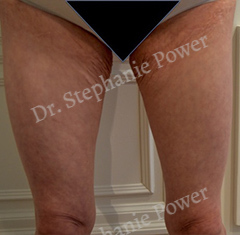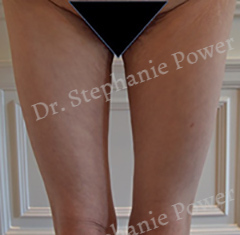THIGH LIFT AT POWER PLASTIC SURGERY
The thighs are a common area of concern for patients following weight loss or aging as the skin loses elasticity. Patients may develop loose skin and soft tissues along the medial (inner) or lateral (outer) thigh. Thigh lift surgery may be performed to correct skin redundancy and to improve thigh contour. It lifts and tightens the descended soft tissues. Incision placement varies based on the location and degree of skin redundancy. Incisions range from a transverse scar within the groin crease, which may address a limited degree of skin redundancy of the medial thigh, to a longer vertical incision extending along the medial thigh to just above knee level for more pronounced cases. Lateral thigh lift surgery places the scar along the upper-outer thigh to resuspend the soft tissues of the lateral and anterior (front) thigh.
Thigh lift is performed under general anesthetic as out-patient surgery. A compression garment may be recommended for one month depending on the extent of surgery, which may be concealed under clothing. Patients are generally able to return to work within 1-2 weeks of surgery, however must refrain from strenuous activity or heavy lifting for 4-6 weeks post-operatively.
What are common concerns of patients considering thigh lift?
Patients considering thigh lift surgery commonly express concern regarding the appearance of loose skin and soft tissue descent of the medial or lateral thighs. They often wish to tighten the skin envelope and lift the soft tissues to improve aesthetic contour. Concerns regarding thigh appearance are common following massive weight loss, particularly following bariatric surgery.
Who is a suitable candidate for a thigh lift?
A suitable candidate for thigh lift presents with redundant skin of the thighs and fatty tissue to a lesser degree. It is not an effective technique to achieve weight loss or to reduce overall thigh circumference. Thigh lift is a contouring procedure that is most powerful in tightening the skin envelope. It is less effective in removing redundant fatty tissue. If patients present with excess fat deposits of the thighs with normal skin elasticity, liposuction may be an option. If fatty deposits and loose skin are both present, sometimes a combination of liposuction and thigh lift may be recommended. A suitable candidate for thigh lift is an otherwise healthy non-smoker or with well-controlled medical conditions. Smoking cessation is important for one month pre- and post-operatively at minimum to lower risk of healing complications. Realistic expectations and a thorough understanding of risks and benefits of thigh lift are also essential before proceeding with surgery. Patients must understand the trade-off to improving thigh contour is the resultant scarring.
What are different types of thigh lift?
Medial and lateral thigh lifts are the two main types of thigh lift to improve appearance of the inner and outer thigh, respectively. The most appropriate technique will be based on a patient’s aesthetic goals and clinical presentation.
MEDIAL THIGH LIFT
A medial thigh lift may be performed through a limited incision hidden in the groin crease for cases with mild skin redundancy limited to the upper medial thigh. This limited medial thigh lift generally will not improve the appearance of the middle and lower thirds of the thigh. A standard medial thigh lift involves an L- or T-shaped incision extending from the groin to just above knee level to achieve a more powerful tightening effect along the length of the medial thigh.
LATERAL THIGH LIFT
A lateral thigh lift may address redundant skin and resuspend soft tissues of the lateral and frontal thigh regions through an incision at hip level that may be concealed by swimwear.
What to expect after a thigh lift?
Surgery is performed under general anesthetic in an operating room setting. You will awaken in the post-operative recovery room. Once meeting criteria for discharge (tolerating oral analgesia and fluids, ambulating to the washroom with assistance, and feeling comfortable), patients are discharged home with a companion. It is required to have a responsible adult stay with you for 24 hours following a general anesthetic. Walking short distances within your home is encouraged during early recovery to lower risk of thromboembolic complications (DVT or PE). Longer walks and strenuous exercise should be avoided over one month post-operatively until incisions are well-healed. Narcotic pain medication is commonly required for a few days post-operatively. It is encouraged to wean prescription pain medication as soon as possible to lower risk of side effects and further complications. Bruising and swelling is common during early healing. You will receive detailed instructions regarding showering and wound care as healing takes place. The majority of sutures are dissolving. They resorb over a few months post-operatively and decrease wound tension as healing occurs. A few interrupted permanent stitches are often placed along the incisions for reinforcement given the body site, which are removed approximately 10 days after thigh lift.
What is the anticipated recovery after thigh lift?
Patients may return to office-based work within 1-2 weeks. Jobs with more strenuous responsibilities may require longer recovery and should be discussed with Dr. Power pre-operatively. Swelling resolves over several months post-operatively. Bruising is also common during early healing. Final results after thigh lift may take up to one year as scar maturation completes.
How much should I weigh before considering thigh lift?
It is recommended to achieve a healthy BMI less than 30, ideally closer to 25 or less, before undergoing thigh lift. Thigh lift may not be recommended for patients at higher body mass index with increased risk of healing complications or if a satisfactory aesthetic outcome is not anticipated. Given that a component of the scar is placed at groin level, higher body mass index with greater skin-on-skin contact at this site may increase risk of healing complications, including delayed wound healing, wound separation (dehiscence), infection, and poor aesthetic outcome. If weight loss is in progress, it is recommended to achieve a healthy and stable body weight for at least 3 months pre-operatively.
What are potential complications of a thigh lift?
Thigh lift is generally a well-tolerated surgical procedure in appropriately selected candidates who follow recommended wound care instructions and activity modifications post-operatively. Local risks of thigh lift include bleeding and hematoma, which refers to a collection of blood or ongoing bleeding within the tissues. If one side becomes very firm, bruised, and more swollen than the other, it is important to contact Dr. Power urgently to schedule clinical reassessment. Instructions will be given pre-operatively to hold certain medications that may increase risk of bleeding. Cold compresses post-operatively and avoidance of exercise and strenuous activity may also reduce risk of bleeding.
Infection is of greater risk given the body site. Prophylactic antibiotics are commonly prescribed for 5 days post-operatively to lower risk of infection. Detailed wound care instructions will be provided. Washing the surgical sites daily in the shower with soap and running water may reduce the bacterial load and lower risk of infection.
Additional local risks of thigh lift include altered sensation, asymmetry, lymphedema, and scar migration if increased tension is placed on the wounds. This may increase visibility of scars at the groin crease. Sensory changes generally improve over a few months post-operatively. There is also risk of hypertrophic scarring and delayed wound healing. If risk factors for greater scarring are identified during consultation, further recommendations will be discussed. Dissatisfaction with aesthetic outcome is a risk of any cosmetic procedure. Selecting appropriate candidates with well-defined and realistic expectations is important to increase the likelihood of achieving a satisfactory aesthetic outcome with high patient satisfaction.
Risk of systemic complications following thigh lift includes thromboembolic events (DVT and PE). Early ambulation is encouraged to lower risk of developing blood clots. Longer walks and strenuous exercise should be avoided for 4-6 weeks post-operatively until well-healed. Risks and benefits of thigh lift will be discussed in detail during consultation as part of the informed consent process.




"The biggest hurdle for a lot of women is coming in for the consultation. Many do not want to appear vain or they feel guilty about finally spending money on themselves."
- DR. STEPHANIE POWER